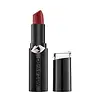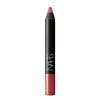What's inside
What's inside
 Key Ingredients
Key Ingredients

 Benefits
Benefits

 Concerns
Concerns

 Ingredients Side-by-side
Ingredients Side-by-side

Pentaerythrityl Tetraisostearate
EmollientIsononyl Isononanoate
EmollientOzokerite
Emulsion StabilisingKaolin
AbrasiveTriethylhexanoin
MaskingHydrogenated Microcrystalline Wax
Emulsion StabilisingSynthetic Wax
AbrasiveSilica
AbrasiveOleic/Linoleic/Linolenic Polyglycerides
EmollientMethyl Methacrylate Crosspolymer
Hdi/Trimethylol Hexyllactone Crosspolymer
Bis-Behenyl/Isostearyl/Phytosteryl Dimer Dilinoleyl Dimer Dilinoleate
EmollientCaprylic/Capric Triglyceride
MaskingHydrogenated Vegetable Oil
EmollientTrimethylpentanediol/Adipic Acid/Glycerin Crosspolymer
Skin ConditioningHydrogenated Styrene/Methylstyrene/Indene Copolymer
Dimethicone/Vinyl Dimethicone Crosspolymer
Skin ConditioningDipentaerythrityl Hexa C5-9 Acid Esters
Skin ConditioningMyristyl Lactate
EmollientBis-Diglyceryl Polyacyladipate-2
EmollientTriheptanoin
Skin ConditioningPhytosteryl Macadamiate
Skin ConditioningHelianthus Annuus Seed Oil
EmollientTocopheryl Acetate
AntioxidantPrunus Amygdalus Dulcis Oil
Skin ConditioningPhenoxyethanol
PreservativeSorbic Acid
PreservativeAstrocaryum Murumuru Seed Butter
EmollientPassiflora Edulis Seed Oil
EmollientPhytosteryl Oleate
Skin ConditioningTocopherol
AntioxidantArgania Spinosa Kernel Oil
EmollientMacadamia Integrifolia Seed Oil
Skin ConditioningEthylhexylglycerin
Skin ConditioningCocos Nucifera Oil
MaskingGlyceryl Caprylate
EmollientWater
Skin ConditioningGlycine Soja Oil
EmollientPentaerythrityl Tetra-Di-T-Butyl Hydroxyhydrocinnamate
AntioxidantSodium Hyaluronate
HumectantCI 42090
Cosmetic ColorantCI 77491
Cosmetic ColorantCI 77492
Cosmetic ColorantCI 77499
Cosmetic ColorantCI 45410
Cosmetic ColorantCI 15850
Cosmetic ColorantCI 77891
Cosmetic ColorantCI 19140
Cosmetic ColorantCI 15985
Cosmetic ColorantPentaerythrityl Tetraisostearate, Isononyl Isononanoate, Ozokerite, Kaolin, Triethylhexanoin, Hydrogenated Microcrystalline Wax, Synthetic Wax, Silica, Oleic/Linoleic/Linolenic Polyglycerides, Methyl Methacrylate Crosspolymer, Hdi/Trimethylol Hexyllactone Crosspolymer, Bis-Behenyl/Isostearyl/Phytosteryl Dimer Dilinoleyl Dimer Dilinoleate, Caprylic/Capric Triglyceride, Hydrogenated Vegetable Oil, Trimethylpentanediol/Adipic Acid/Glycerin Crosspolymer, Hydrogenated Styrene/Methylstyrene/Indene Copolymer, Dimethicone/Vinyl Dimethicone Crosspolymer, Dipentaerythrityl Hexa C5-9 Acid Esters, Myristyl Lactate, Bis-Diglyceryl Polyacyladipate-2, Triheptanoin, Phytosteryl Macadamiate, Helianthus Annuus Seed Oil, Tocopheryl Acetate, Prunus Amygdalus Dulcis Oil, Phenoxyethanol, Sorbic Acid, Astrocaryum Murumuru Seed Butter, Passiflora Edulis Seed Oil, Phytosteryl Oleate, Tocopherol, Argania Spinosa Kernel Oil, Macadamia Integrifolia Seed Oil, Ethylhexylglycerin, Cocos Nucifera Oil, Glyceryl Caprylate, Water, Glycine Soja Oil, Pentaerythrityl Tetra-Di-T-Butyl Hydroxyhydrocinnamate, Sodium Hyaluronate, CI 42090, CI 77491, CI 77492, CI 77499, CI 45410, CI 15850, CI 77891, CI 19140, CI 15985
C12-13 Alkyl Ethylhexanoate
EmollientSynthetic Candelilla Wax
EmollientPolyethylene
AbrasiveCaprylyl Methicone
Skin ConditioningCyclopentasiloxane
EmollientSilica
AbrasiveDimethicone
EmollientSucrose Acetate Isobutyrate
Hydrogenated Coco-Glycerides
EmollientDisteardimonium Hectorite
StabilisingPropylene Carbonate
SolventLecithin
EmollientMethylparaben
PreservativePropylparaben
PreservativeAroma
Tocopherol
AntioxidantAscorbyl Palmitate
AntioxidantDicalcium Phosphate
AbrasiveCitric Acid
BufferingBHT
AntioxidantAnise Alcohol
PerfumingMica
Cosmetic ColorantCI 77891
Cosmetic ColorantCI 77491
Cosmetic ColorantCI 77492
Cosmetic ColorantCI 77499
Cosmetic ColorantCI 15850
Cosmetic ColorantCI 19140
Cosmetic ColorantC12-13 Alkyl Ethylhexanoate, Synthetic Candelilla Wax, Polyethylene, Caprylyl Methicone, Cyclopentasiloxane, Silica, Dimethicone, Sucrose Acetate Isobutyrate, Hydrogenated Coco-Glycerides, Disteardimonium Hectorite, Propylene Carbonate, Lecithin, Methylparaben, Propylparaben, Aroma, Tocopherol, Ascorbyl Palmitate, Dicalcium Phosphate, Citric Acid, BHT, Anise Alcohol, Mica, CI 77891, CI 77491, CI 77492, CI 77499, CI 15850, CI 19140
Ingredients Explained
These ingredients are found in both products.
Ingredients higher up in an ingredient list are typically present in a larger amount.
Ci 15850 is the pigment color red. It is an azo dye and created synthetically.
Azo dyes need to be thoroughly purified before use. This allows them to be more stable and longer-lasting.
This ingredient is common in foundations, lipsticks, and blushes. This color is described as brown/orangey red.
It has many secondary names such as Red 6 and Red 7. According to a manufacturer, Red 6 usually contains aluminum.
Learn more about CI 15850CI 19140 is also known as Tartrazine. Tartrazine is a synthetic dye used in cosmetics, foods, and medicine to add a yellow color.
Tartrazine is created from petroleum and is water-soluble.
Some people may experience allergies from this dye, especially asthmatics and those with an aspirin intolerance.
Learn more about CI 19140Ci 77491 is also hydrated iron III oxide. It's sole purpose is to give a red/pink hue to products.
Iron III oxides are classified as inorganic chemicals for coloring.
Synthetically created Ci 77491 is considered safer than those naturally found. This is because the synthetically created version may contain less impurities. Iron oxides are generally non-toxic and non-allergenic.
Learn more about CI 77491Ci 77492 is also hydrated iron III oxide. It's sole purpose is to give a yellow hue to products.
Iron III oxides are classified as inorganic chemicals for coloring.
Synthetically created Ci 77492 is considered safer than those naturally found. This is because the synthetically created version may contain less impurities. Iron oxides are generally non-toxic and non-allergenic.
Learn more about CI 77492Ci 77499 is also hydrated iron III oxide. It is created from mixing red and black iron oxides. This helps give shades of darkness to a product.
Iron III oxides are classified as inorganic chemicals for coloring.
Ci 77891 is a white pigment from Titanium dioxide. It is naturally found in minerals such as rutile and ilmenite.
It's main function is to add a white color to cosmetics. It can also be mixed with other colors to create different shades.
Ci 77891 is commonly found in sunscreens due to its ability to block UV rays.
Learn more about CI 77891Silica, also known as silicon dioxide, is a naturally occurring mineral. It is used as a fine, spherical, and porous powder in cosmetics.
Though it has exfoliant properties, the function of silica varies depending on the product.
The unique structure of silica enhances the spreadability and adds smoothness, making it a great texture enhancer.
It is also used as an active carrier, emulsifier, and mattifier due to its ability to absorb excess oil.
In some products, tiny microneedles called spicules are made from silica or hydrolyzed sponge. When you rub them in, they lightly polish away dead skin layers and enhance the penetration of active ingredients.
Learn more about SilicaTocopherol (also known as Vitamin E) is a common antioxidant used to help protect the skin from free-radicals and strengthen the skin barrier. It's also fat soluble - this means our skin is great at absorbing it.
Vitamin E also helps keep your natural skin lipids healthy. Your lipid skin barrier naturally consists of lipids, ceramides, and fatty acids. Vitamin E offers extra protection for your skin’s lipid barrier, keeping your skin healthy and nourished.
Another benefit is a bit of UV protection. Vitamin E helps reduce the damage caused by UVB rays. (It should not replace your sunscreen). Combining it with Vitamin C can decrease sunburned cells and hyperpigmentation after UV exposure.
You might have noticed Vitamin E + C often paired together. This is because it is great at stabilizing Vitamin C. Using the two together helps increase the effectiveness of both ingredients.
There are often claims that Vitamin E can reduce/prevent scarring, but these claims haven't been confirmed by scientific research.
Learn more about Tocopherol